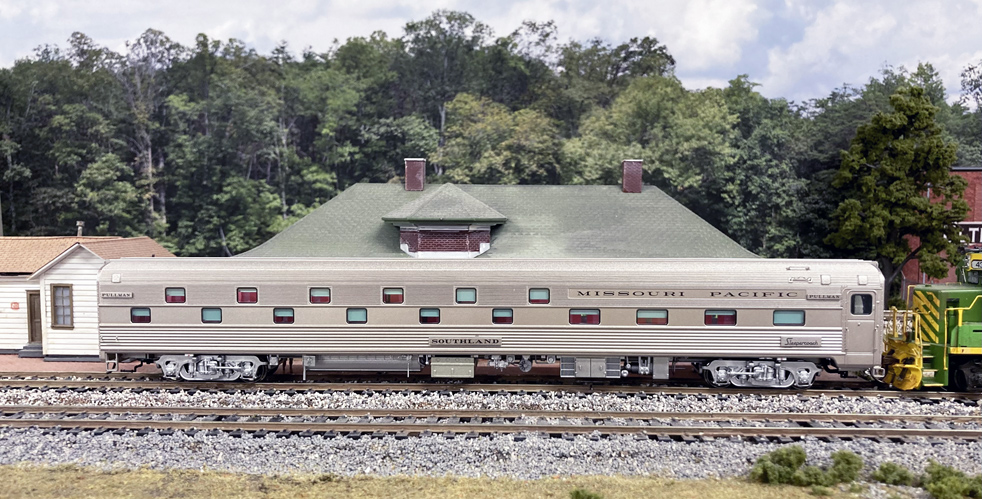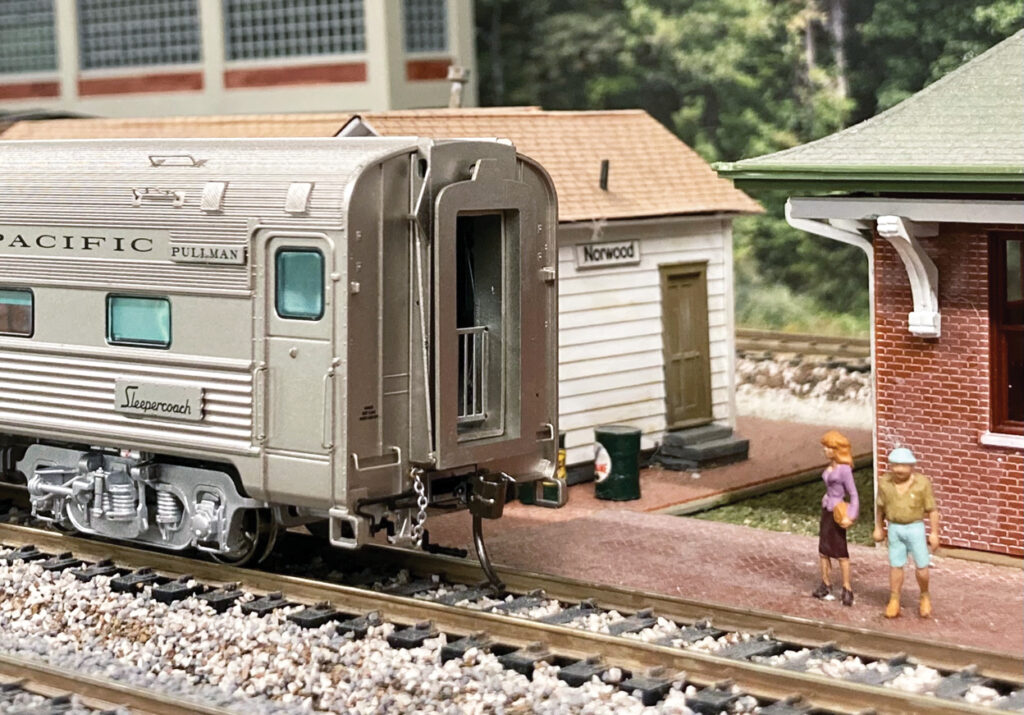All about the community of model railroading and rail enthusiasm
August 29, 2024

Never mind that the Rapido HO Budd Slumbercoach is a strong reminder of passenger rail travel in the 1950s. You easily could see yourself in it today.
Look in one of the several mirrors inside the model released earlier this year – and see your own reflection! It’s like going back in time.
Rapido Trains’ Missouri Pacific No. 699 Pullman “Southland,” sent for review to the Cowcatcher, features full multicolored interiors and prototypical detail top to bottom.
The Budd Co. introduced Slumbercoaches in 1956-58 as a cost-effective means for overnight travel to compete with airlines.
The cars, which ran into the 1990s, consisted of 24 single-occupant and eight double-occupant rooms, each with a seat that could convert into a bunk. Rooms were staggered between upper and lower bunks directly above or beneath the bunk of the adjacent room, according to the description of NP No. 325 on the Illinois Railway Museum’s website.
Slumbercoaches were positioned between coach seating and a first-class bedroom on overnight runs. Single and double rooms flanked an aisle in the center of the car.
Budd delivered 18 cars — five to the Baltimore & Ohio and four each to the New York Central, Northern Pacific, and Chicago, Burlington and Quincy. The Missouri Pacific got one.
The cars with their distinctive staggered windows could be seen on some of the most famous trains in the U.S., including the “North Coast Limited,” “Denver Zephyr,” “National Limited” and “Texas Eagle.” Eventually, Amtrak acquired the fleet. Today some reside in museums or are owned privately.
Rapido toured IRM’s Northern Pacific Budd Slumbercoach a couple of years ago for research. Original blueprints were used to recreate the as-built steam heat-equipped cars.
The models feature constant track-powered interior lighting (DC and DCC) that can be turned on and off with an enclosed magnetic wand. They have accurate GSC 41-NDO-11 trucks with disc brake detail, etched-metal end gates and sprung diaphragms, stainless-steel finish and separately applied name boards.
The MoPac model sent didn’t seem all that unusual in its standard Rapido blue packaging, but once freed from the box the craftsmanship told a remarkable story.
Rapido’s classic stainless finish and signage jumped out, and a side view of the equipment underneath demanded a closer look. So did the interior after a flick of the lights with the wand.
But first, No. 699 got a ride on the Northwest Tarrant & Pacific. The model tracked well and the couplers are an improvement over previous Rapido passenger models, hooking easily to the lead locomotive.
The car was pushed and pulled a few times down the main line before pulling into the depot at Norwood for photographing.

Next came a peek under and inside the car.
Known for its underbody detail, Rapido raises the bar with the MoPac Slumbercoach. The underside is loaded with prototypical equipment, including the generator motor and cabling, reservoirs, control and service valves, brake equipment, disc brake detail on the wheels, steam pipes and air-conditioning, and steam heating equipment.
The see-through a/c compressor unit with its multiple parts and separate metal pipes leading to the back of the unit is impressive.
True to the prototype, the underbody is painted silver.
“It’s all here,” Rapido CEO Jason Shron says in a video on the company’s website.

Now the interior, but the shell had to come off.
The coupler boxes, each held by a small screw, needed to go, but removing the couplers was tedious because of piping directly above the box. The piping was gently shoved aside to loosen and remove the screws. With a little push, the coupler boxes were free.
The shell came loose by gently prying each of the long sides. Removing it revealed the multicolored interior. Like the prototype, the roomettes had a chair and a mirror on the door.
Rapido replicated the rooms with real mirrors.
“If you look inside our windows you can see there are multicolored interiors and all the doors have mirrors on them,” Shron says on the video. “We went to the Illinois Railway Museum and we saw mirrors, so we had the factory put mirrors on them.”

He says the mirrors and underbody detail separate Rapido’s Budd MoPac Slumbercoach from the competition: “If you were to compare this Slumbercoach with any other passenger car models other than Rapido, you’re going to realize the level of detail here is higher up.”
In addition to the “Southland,” the Rapido HO Budd Slumbercoach is produced in Amtrak Phase I, Amtrak Phase 3, Baltimore & Ohio, Burlington Northern, New York Central, Northern Pacific (including No. 325) and Chicago, Burlington & Quincy. Each road comes in multiple name cars and numbers.
An undecorated version also is available.
Recommended minimum radius is 22 inches. A long-shank coupler is included for tight curves.
Cars list for $119.95 US on Rapido’s website.
Rapido, which is celebrating its 20th anniversary in 2024, wanted to top itself on this one.
“It’s a beautiful car,” Shron says on the video. “I think it’s one of the nicest ones we’ve done here.”
He just may be right.